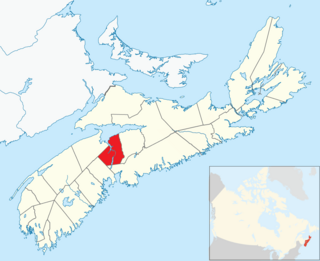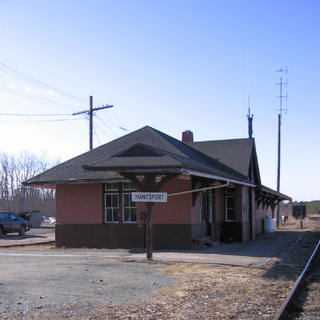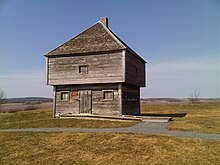Windsor is a community located in Hants County, Nova Scotia, Canada. It is a service centre for the western part of the county and is situated on Highway 101.

The Minas Basin is an inlet of the Bay of Fundy and a sub-basin of the Fundy Basin located in Nova Scotia, Canada. It is known for its extremely high tides.

East Hants, officially named the Municipality of the District of East Hants, is a district municipality in Hants County, Nova Scotia, Canada. Statistics Canada classifies the district municipality as a municipal district.
Hantsport is an unincorporated area in the West Hants Regional Municipality, Nova Scotia, Canada. It is at the western boundary between West Hants Regional Municipality and Kings County, along the west bank of the Avon River's tidal estuary. The community is best known for its former industries, including shipbuilding, a pulp mill, as well a marine terminal that once loaded gypsum, mined near Windsor. The community is the resting place of Victoria Cross recipient William Hall.

Ezra Churchill : Nineteenth-century industrialist, investing in shipbuilding, land, timber for domestic and foreign markets, gypsum quarries, insurance companies, hotels, etc. As a politician he held positions in the Nova Scotia legislature and was appointed a Canadian Senator for the Province of Nova Scotia. Churchill was also a Baptist lay preacher.

West Hants, officially named the West Hants Regional Municipality, is a regional municipality in Hants County, Nova Scotia, Canada.

The New England Planters were settlers from the New England colonies who responded to invitations by the lieutenant governor of Nova Scotia, Charles Lawrence, to settle lands left vacant by the Bay of Fundy Campaign (1755) of the Acadian Expulsion.

The 84th Regiment of Foot was a British regiment in the American Revolutionary War that was raised to defend present day Ontario, Quebec and Atlantic Canada from the constant land and sea attacks by American Revolutionaries. The 84th Regiment was also involved in offensive action in the Thirteen Colonies; including North Carolina, South Carolina, Georgia, Virginia and what is now Maine, as well as raids upon Lake Champlain and the Mohawk Valley. The regiment consisted of 2,000 men in twenty companies. The 84th Regiment was raised from Scottish soldiers who had served in the Seven Years' War and stayed in North America. As a result, the 84th Regiment had one of the oldest and most experienced officer corps of any regiment in North America. The Scottish Highland regiments were a key element of the British Army in the American Revolution. The 84th Regiment was clothed, armed and accoutred the same as the Black Watch, with Lieutenant Colonel Allan Maclean commanding the first battalion and Major General John Small of Strathardle commanding the second. The two Battalions operated independently of each other and saw little action together.

Burntcoat Head is an unincorporated rural Canadian community in Hants County, Nova Scotia. The area is known for having the largest tidal range of any location in the world.

Walton is a village in the Canadian province of Nova Scotia, located in the Municipal District of East Hants, Nova Scotia. The community is named after John Nutting's son James Walton Nutting.
Kennetcook is a community in the Canadian province of Nova Scotia, located in the Municipal District of East Hants. Also see adjacent community of Upper Kennetcook.
Rawdon is a former township in the Canadian province of Nova Scotia. The township was the eventual destination of Loyalists fleeing the Siege of Ninety Six during the American Revolutionary War. In 1861, along with the township of Douglas, Nova Scotia, the Rawdon township became part of the newly-formed Municipal District of East Hants, along with neighbouring townships.
St. Croix is a community in the province of Nova Scotia Canada, located in Hants County, Nova Scotia.
Scotch Village is an unincorporated community on the Kennetcook River in the Canadian province of Nova Scotia, located in the Municipality of West Hants. This area was part of Newport Township at the time of settlement primarily by Rhode Island Planters in the early 1760s. It was referred to as “Scotchman’s Dyke” or “Scotch Village”, due to settlement of early families of Scottish descent. Prior to the arrival of the Planters, Scotch Village had been the home of Mi'kmaq and Acadians.
Mount Denson is a small community in the Canadian province of Nova Scotia, located in The Municipality of the District of West Hants in Hants County. The community is named after Mount Denson; the mid-eighteenth-century estate of Henry Denny Denson.
Summerville is a small community in the Canadian province of Nova Scotia, located in The Municipality of the District of West Hants in Hants County. As of 2015, the population of Summerville was estimated to be 248.
Selma is a small community in the Canadian province of Nova Scotia, located in The Municipality of the District of East Hants in Hants County.
Midland Railway was a Nova Scotian railway company formed in 1896 to build a railway through Hants County, Nova Scotia, connecting Truro to Windsor. Completed in 1901, it operated independently until 1905 when it became part of the Dominion Atlantic Railway and later the Canadian Pacific Railway, until the line closed in 1983.

Hantsport station in Hantsport, Nova Scotia, Canada, was built in 1944 as a replacement for an earlier station destroyed by fire in 1943. The brick Tudor revival station was designed by Canadian Pacific Railway architects. The station played an important role in controlling the large shipments of gypsum through the port of Hantsport by the Dominion Atlantic Railway and later the Windsor and Hantsport Railway until 2011 when the gypsum mines around Windsor closed. The station is protected by both federal and provincial heritage laws. It was designated a historic railway station by the federal government in 1992 and as a provincial heritage building in 1995.













